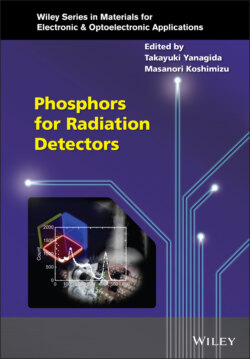Читать книгу Phosphors for Radiation Detectors - Группа авторов - Страница 19
1.3.4 Timing Properties
ОглавлениеTiming properties are also important for scintillation detectors, and depend on the rise and decay times of scintillators and photodetectors. Generally, we analyze the decay time profile by the sum of multi exponential functions, which can be understood as a typical rate equation. Here, we assume radiative and non‐radiative rate constants of kr and knr, respectively. N(t) is the number of excited states, and it shows a relaxation with a rate of –ΔNr during a very short time of Δt. This can be formulated as
The number of the decrease of excited states –ΔNnr is expressed as
Totally, the decrease of the excited states –ΔN is a sum of Equations (1.20) and (1.21), and it can be expressed as
(1.22)
Thus, we can obtain
(1.23)
We can solve this differential equation as
(1.24)
where N0 means the number of luminescence centers at t = 0. If we define kr + knr = 1/τ, we can obtain a typical decay time function for the analysis. Unlike the case of the decay time, the common confirmed analysis method for the rise time has not yet been constructed. One of the problems with the rise time is that it is too fast for typical photodetectors and irradiation sources to observe. Except for scintillators with very slow rise times, the typical rise time is in the order of ~ps, and it is technically difficult to detect such a fast phenomenon.
To date, unlike the situation of scintillation light yield, no widely accepted and confirmed model has been constructed. We apply a common model of PL to understand the scintillation phenomenon. The common relationship between scintillation decay time is expressed as
where Γ means the radiative decay rate, τ is the decay time, R is the refractive index, λ is the emission wavelength, ψexcite is the wave function of excited state, ψexcite is the wave function of ground state, and μ is the electric dipole operator between the initial lowest energy of excited state and the final state of the configuration, respectively [68]. Based on this relationship, we understand that scintillators with shorter emission wavelengths show smaller decay times if we compare them with scintillators possessing the same emission mechanisms (e.g., comparison among d‐f transitions). Figure 1.7 shows the relationship between the scintillation decay time and emission wavelength of some common materials. In this plot, we use Ce3+, Pr3+, and Nd3+ doped samples, and the emission mechanism of all the samples is 5d‐4 transition. A clear proportional relationship based on Equation (1.25) is clearly observed. Typically, emission wavelength due to d‐f transitions of Ce3+, Pr3+, and Nd3+ appear in the visible, ultraviolet, and vacuum ultra violet wavelengths, respectively. If we plot the same relationship on 4f‐4f transitions of rare earth ions, a similar relation will be obtained, but it is technically difficult to measure the scintillation decay time of near infrared emission, which is the typical emission wavelength of 4f‐4f transition of rare earth ions.
Figure 1.7 Relationship between the scintillation decay time (ns) and emission wavelength (nm).
In some specific applications, a very fast response is required, and in such a case, timing resolution is important. The timing resolution is not a physical property of each material but a detector property depending on properties of detector components, including scintillators, photodetectors, and readout electronics. Although there is no clear numerical function form, the timing resolution is a function of scintillation light yield, rise, and decay times. In order to achieve a high timing resolution, fast rise and decay times accompanied with a high light yield are required. In addition, fast rise and decay times of photodetector are also required. The recent timing resolution is ~100 ps [69], and in time‐of‐flight positron emission tomography (TOF‐PET), 100 ps timing resolution corresponds, for example, to 3 cm localization limitation of a tumor.
The other important property of the scintillation detector is an afterglow, which mainly affects integration‐type detectors such as X‐ray CT and security systems. If the afterglow is huge, the S/N and spatial resolution in the radiation image degrade. Because the main target is the human body, X‐ray CT requires very low afterglow levels for scintillators, and typical afterglow levels are few, at the ppm level. Among commercial scintillators, BGO and CdWO4 are known to show very low afterglow levels, and GOS also shows a relatively low afterglow level. Taking into account the balance of light yield and afterglow, most X‐ray CT use GOS as a main device. In security systems, Tl‐doped CsI is widely used, since it shows a high emission intensity with very low cost, although the afterglow level is the poorest among these commercial scintillators. Physically, the afterglow is TSL at room temperature, and scintillators for integration‐type detector should not have TSL glow peaks below 100 °C. On the other hand, except for very huge afterglow, photon counting‐type detectors can ignore the afterglow because it generally appears as a very small pulse with a high frequency, and is generally cut by lower threshold level of the electronics. Details of TSL is described in Chapter 7, and is a scientifically interesting topic deeply related to afterglow in long persistent luminescence for night illuminations [70].
